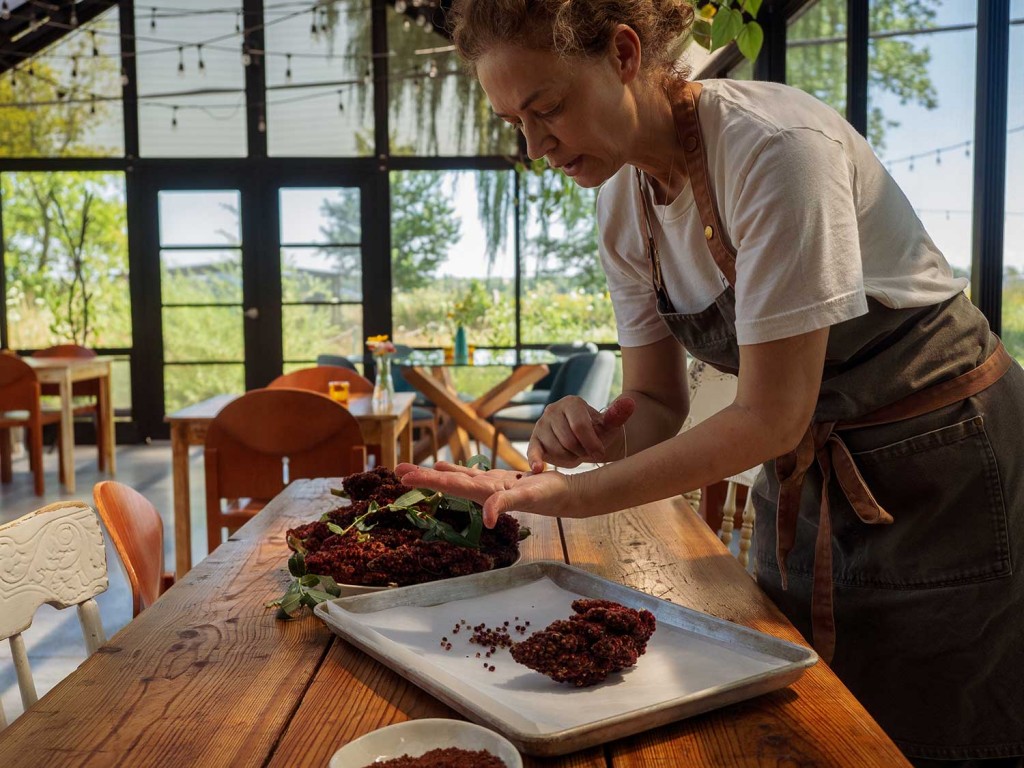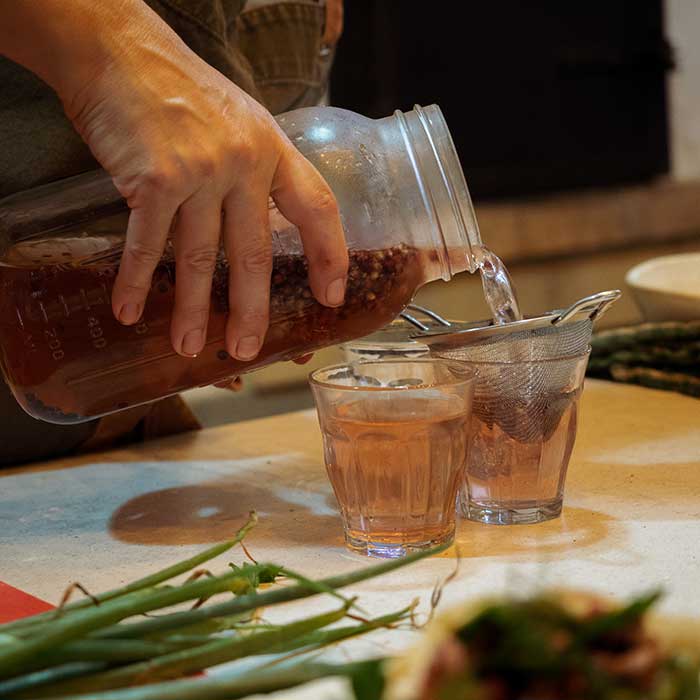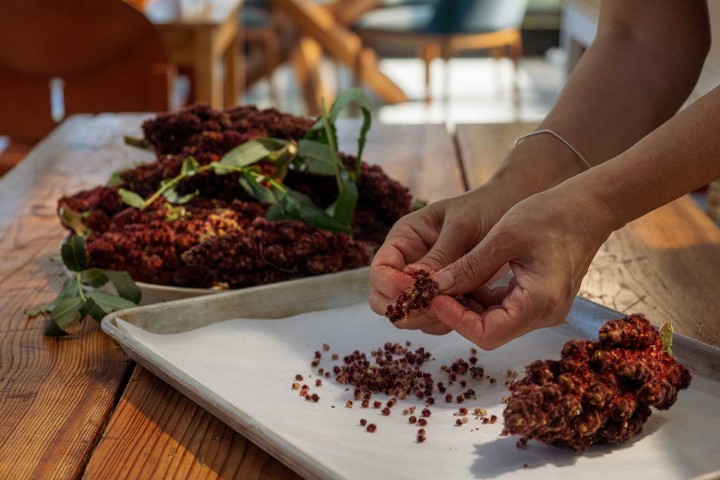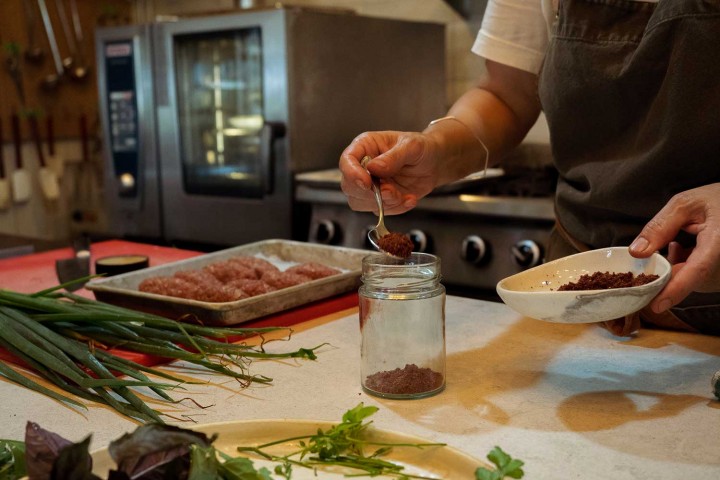Atelier
How to Forage and Cook with Sumac
Sumac is easy to forage and a delicious addition to many recipes. Here are some tips and tricks to get started.
Text—Catherine Lefebvre
Photos—Jad Haddad
Sumac is a prized ingredient in Middle Eastern and central Asian cuisine. Its vibrant colour — ranging from dark red to purple — and tangy taste make it an especially attractive ingredient in cooking. The flamboyant seed heads, called “bobs,” stand proudly in the dozens on each tree, full of tiny, fuzzy, ruby-coloured fruits.
Traditionally used in powdered form, this condiment lends distinct flavours to vinaigrettes, such as the incomparable fattoush salad. In Iran, Iraq, and Turkey, it’s used to season pilaf, a rice dish spiced with saffron, cardamom, and turmeric.
Sumac is also an integral part of zaatar, an essential spice blend in Eastern cuisine. Mixed with wild thyme and sesame seeds, it brings a note that’s both herbal and tangy to manakish, the oven-baked flatbreads eaten at breakfast or on the go in places like Lebanon, Syria, and Jordan.

Foraging for sumac
Although sumac may seem to be a new and unfamiliar ingredient, it has been growing wild throughout much of North America for centuries. Staghorn sumac, the common name of one of the most predominant species, is found south of the Great Lakes and in southeastern Ontario, in Québec and the Maritimes, and in New England. It can regularly be seen at the side of the road in the country, but also in urban environments.
Cycling paths are a good starting place to find sumac. One thing is certain: with its flashy red bobs, it’s hard to miss.

Well-known foragers Gérald Le Gal and Ariane Paré-Le Gal recommend using a stepladder and long-handled pruning shears — good tools to reach the seed heads, especially if the tree is large or more difficult to access.
“Because they are fruits, they can be collected in large quantities without a problem,” notes Paré-Le Gal. “Sumac reproduces mainly through its root system.” You can still leave some for others and take only what you’re going to use.
Sumac is gathered from late July to late September, ideally, for maximum flavour. Even though staghorn sumac is abundant, it’s a good idea to check with the municipality to see if foraging is permitted. Some rules apply to the harvesting of wild plants and vary from park to park or city to city.
Preparing and cooking sumac
For as long as she can remember, chef Fisun Ercan, originally from Turkey, has added sumac to nearly all her dishes. “I use it by the handful in some recipes, as an herbal garnish for my kefta pitas with garlic yogurt.” So she’s delighted to be able to get her supply locally, right near her farm and farm-to-table restaurant, Bika, in Saint-Blaise-sur-Richelieu.
Once the bobs have been collected, they are rinsed quickly to remove dust and other matter, and then dried in the open air on a cooling rack for 24 hours. “Then they have to be carefully separated by hand,” says Ercan, running her hands over the velvety little balls that she has just broken apart from the bob.
To turn these balls into sumac powder, each one must be completely dry. On a cookie sheet covered in parchment paper, they should be returned once again to the open air, or else dried in a dehydrator or in the oven at a low temperature. “I put them in the oven at 140 °F for four or five hours, depending on the quantity,” Ercan says.
Next, they’re put through the food processor and sifted, so that only the fur is kept. But this last step is merely a question of preference: “I put everything in the coffee grinder,” says Ercan. “This adds a bit of texture to the final product, without altering the flavour.”
Keep the powdered sumac away from light in an airtight container. You can use it all year round.

Sumacade
Yield: 4 ½ cups
INGREDIENTS
- 1 cup fresh sumac, dried and broken up
- 4 ½ cups water
- Honey or maple syrup to taste
INSTRUCTIONS
- Place the sumac berries into a container and add the water.
- Let it steep for at least an hour at room temperature.
- Refrigerate it as is for a stronger flavour concentration, or strain the “sumacade” into another container before refrigerating.
- Sweeten to taste.

Sumac dressing
Yield: ½ cup
INGREDIENTS
- 2 ½ tsp. powdered sumac
- ¼ cup organic sunflower oil
- ½ tsp. honey
- 1 clove garlic, pressed
- Salt to taste
INSTRUCTIONS
- Mix all ingredients in a small jar.
- Serve over lettuce leaves, or as a dip for bread.

Sumac and herb garnish
Yield: 2 cups
INGREDIENTS
- 1 ½ cups fresh herbs of choice (basil, dill, lamb’s quarters, parsley)
- 1 French shallot, finely chopped
- ¼ cup powdered sumac
- 1 Tbsp. chili powder
- 2 Tbsp. organic sunflower oil
- Salt to taste
INSTRUCTIONS
- Mix all ingredients in a bowl
- Serve as a garnish for kefta pitas — oblong meatballs made of ground beef or lamb and spices — or other grilled meats.
Never Miss Another Issue
Two issues per year
25% OFF previous issues
Free Shipping in Canada


